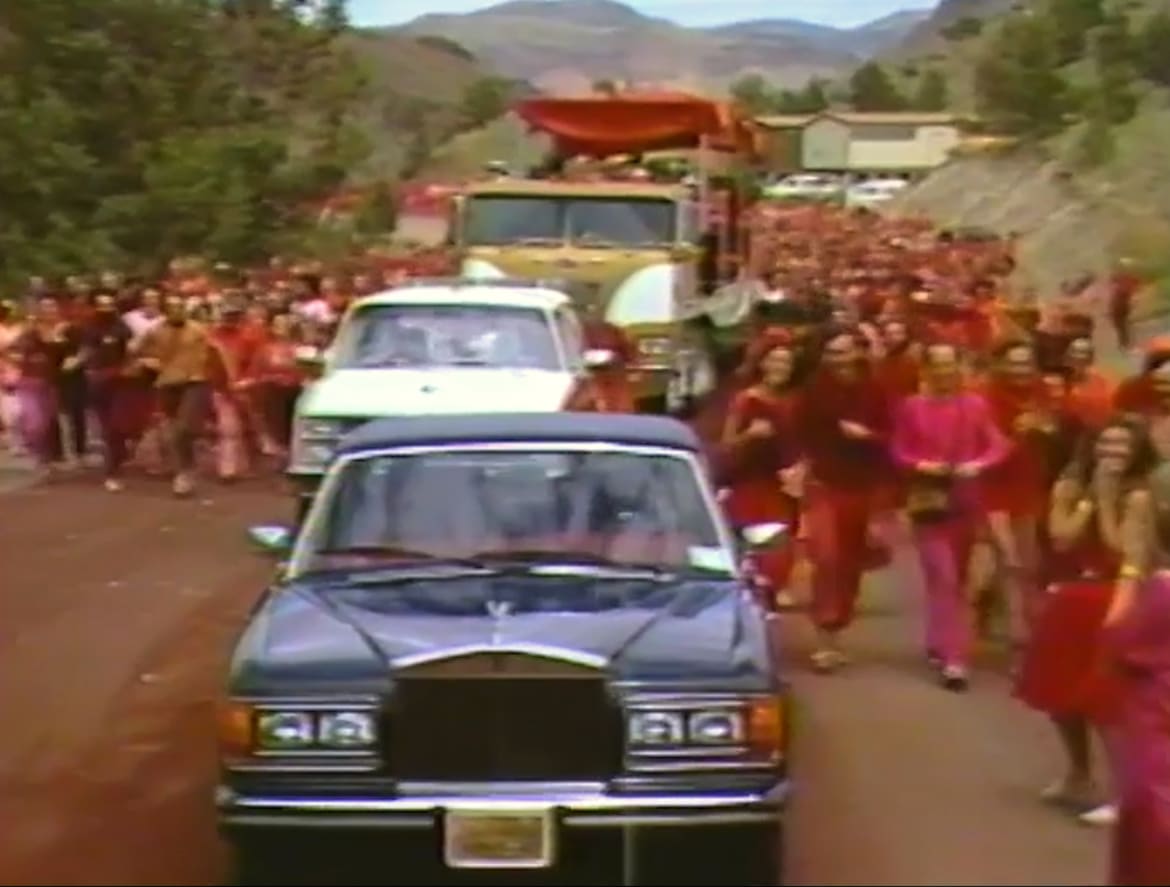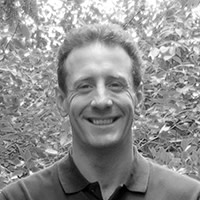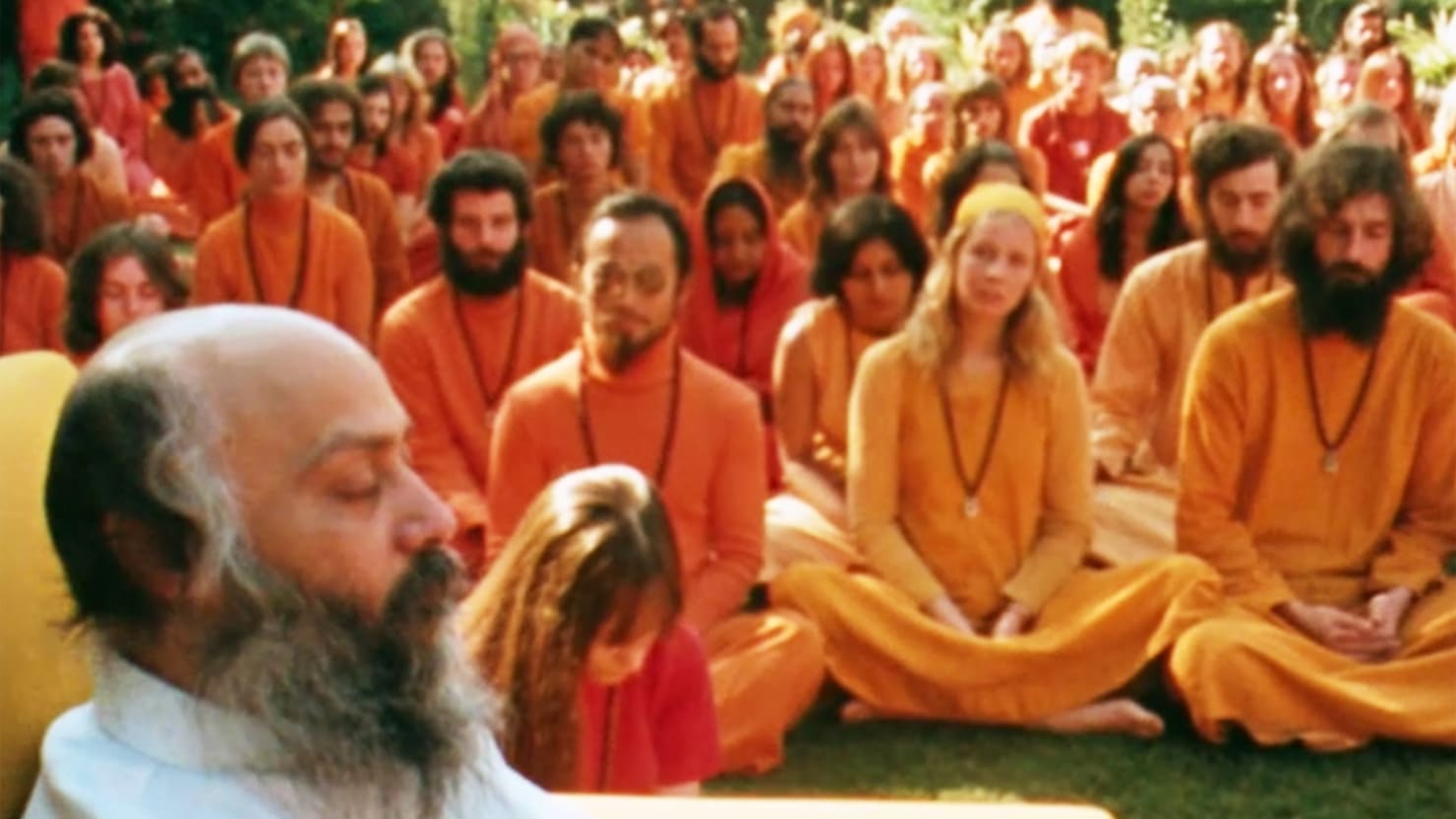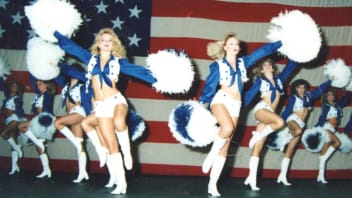In 1981, an Indian guru known as Bhagwan Shree Rajneesh purchased thousands of acres of land in rural Wasco County, Oregon (right next to the tiny town of Antelope), and—with the aid of his red-robed followers, known as “Rajneeshees” or “sannyasins”—began construction on a city-sized commune dubbed “Rajneeshpuram.”
That endeavor sparked bitter fights with Christian locals who didn’t take kindly to being invaded by a New Age-y “sex cult,” and then court battles with state and federal authorities. What followed was an eye-opening saga that eventually involved a massive bioterror attack, assassination attempts, and the largest wiretapping case in American history—much of it centered on the Bhagwan’s fearsome second-in-command, Ma Anand Sheela.
Was this an example of a peaceful religious minority being persecuted for its unconventional views? Or was it an instance of a crazy cult breaking whatever laws it pleased—including committing immigration fraud and stockpiling weapons for “self-defense?”
Wild Wild Country, Netflix’s gripping new six-part documentary series, employs a wealth of stunning archival footage and new interviews—with, among others, a still-defiant Sheela—to tackle a decades-old story that seems to have been forgotten by most of the country, even though its various topics couldn’t be more relevant today. I spoke with the show’s directors, Chapman and Maclain Way, about their in-depth investigation into one of the strangest true-life tales one is ever likely to hear.
The show details this fascinating piece of U.S. history that I knew nothing about. How did you first come to learn about the Bhagwan and Rajneeshpuram?
Chapman: I was born in 1986, and Mac was born in 1991 and we grew up just north of Los Angeles having never heard about the Indian guru Bhagwan Shree Rajneesh, or the city of Rajneeshpuram. It wasn’t until 2014 that we were talking with a film archivist up in Portland who asked us what we were going to do for our next documentary project. Mac and I had a couple of ideas, but nothing we were totally in love with. And he said, “Well, we have this collection of over 300 hours of never-before-seen archival footage about the most bizarre story that ever happened in Oregon.”
He quickly told us about this guru who built this $100 million utopian city, and then they took over the small town of Antelope politically, and then they bussed in thousands of homeless people to take over Wasco County, which then led to this mass poisoning of 750 people. I remember Mac and I looking at each other and saying, “There’s no way he has this story right, because we would have definitely heard about it.” [Laughs] How could something like this have happened in America and you’re not taught about it? We all seem to know about Waco and Jonestown, so how has this slipped under the radar for so long? The first thing we started doing was transferring and digitizing all these old archival tapes. And sure enough, everything this archivist had told us showed up in the footage.
Maclain: We became friendly with these archivists in the Pacific Northwest because of this feature documentary we did on the Portland Mavericks back in 2014 [The Battered Bastards of Baseball]. As you go through the Pacific Northwest film archives, you see a lot of tapes that say “Bhagwan,” or “Rajneesh,” or “Rajneeshpuram,” and I had no idea what those names were.
But I remember the first tape I popped in was of the 1982 World Festival, which we cover in episode three, and I couldn’t believe what I was seeing. As a documentary filmmaker, you’re always keeping an eye out for how to tell a story visually. And visually, what I was seeing on this tape really captivated me: 8,000 people dressed head-to-toe in red who had built this city in the middle of the Oregon desert. After that, we started reaching out to our cast of characters, so to speak—our major talking heads on different sides of this story. Quickly, what we found was that, especially for the Rajneeshees, these years (1981-1985) were the most important thing that had ever happened to them. As a documentary filmmaker, we were really excited that these people had deep, deep stakes in the story.
How long did it take to go through all that archival material?
Chapman: It was a step-by-step process. As soon as we started transferring the archive and doing the initial research, it became clear how complex this story was. It involved religious rights, legal battles revolving around land use and separation of church and state, court battles that went to the Oregon Supreme Court, and huge immigration fraud. Right away, we knew there was no way to tell this story in 90 minutes, because that would just cheapen the story. So early on in 2014, which was before The Jinx and Making a Murderer, and thus before the docuseries had become a cultural phenomenon, we mapped out this story as a six-hour, six-episode project.
Mac and I were very hands-on—we don’t hire interns to go through the footage, we went through every single frame of that footage with a fine-toothed comb to make sure we were leaving nothing on the cutting-room floor. Then, reading books, readying essays, going through federal documents, doing pre-interviews with characters and breaking down the footage, that was about a yearlong process before we jumped into production and started interviewing our characters.
Given that Wild Wild Country came about before true-crime series had really taken off, did you have any idea where it might eventually air?
Chapman: We were kind of forced into it, because like I said, we knew there was just no way to do this in 90 minutes—it wouldn’t make sense. But at the time, distributors were a bit nervous. No one really knew how this format worked. By the time we started pitching it, The Jinx had just come out, so there was this example of what could be told in this longer format. And we got really lucky that we hooked up with Mark and Jay Duplass, who saw a little teaser video we put together. We met with them, and they were immediately attracted to the story for the right reasons, and fell in love with it. They were instrumental in bringing this to distributors and getting excitement on board to make it as a long-form series.
The Bhagwan’s story touches on numerous topics that are relevant today. Was there a point during production when you suddenly realized that the show was becoming intensely timely?
Chapman: It really feels like the world was a completely different place than when we started on this—Obama was president, and there was a lot less political anxiety and tension at the time. We were just fascinated by the topics regardless of their timeliness. During the primaries, when Trump started talking about the Muslim ban, and the xenophobia started popping up, we started to see that there were some similarities here: the fear of the “other,” and fear of religious minority groups and cults. Then, the guns rights issue has just exploded in the last few months, and here was this peace-loving pacifist group that took up the Second Amendment and armed themselves to protect themselves. As we started nearing production on this, it was kind of bizarre how timely these topics became.
How did you track down all of your “characters?” And was anyone particularly difficult to get on-camera?
Chapman: It was difficult on both sides of this issue to get people to sit down and talk to us about this. Both sides feel like they’ve been burned by the media over the years. On the Antelope side, they feel like they’re always stereotyped as one-dimensional bigots who were just racist and didn’t like this Indian guy and his religion. And on the other side, the Rajneeshees feel like they’ve always been characterized as this brainwashed terrorist cult—even though there was this leadership group at the top that committed horrific crimes, while the 95 percent of them on the ranch had no idea what was going on, and were just eating organic food and living in their utopia.
It took a lot of legwork. We spent time in Antelope getting to know their culture and way of life. And we spent a lot of time travelling to Switzerland—I think we took three trips before we even interviewed Ma Anand Sheela, just getting to know her and building a sense of trust. I think that really helped when we sat down with them and filmed their interviews, because there was a rapport between us, and that helped the characters open up on camera.
Maclain: I think with the Rajneeshees, there was this internal battle. I don’t think they really liked that this story had almost been forgotten—or those that did remember it within Oregon remembered them as being this terrorist sex cult. But I think there was this hesitancy, too: “Well, is this a good thing that this is going to be relegated to the dustbins of history, or is it good to spotlight this in a long-form documentary series?” I think Antelopians felt similarly. They were also hesitant about whether they wanted this story spotlighted, or whether they were more comfortable with the fact that it was being forgotten.
Ultimately, most people that we talked to did choose to participate, and I think that’s because, interestingly enough, both sides saw that Rajneeshpuram could serve as a warning. Obviously, they had vastly different perceptions of what that warning is. I think Rajneeshees view Rajneeshpuram as a warning about what happens when minority religious groups are persecuted. I think Antelopians look at Rajneeshpuram as a warning about the dangers of cults and what happens when people become brainwashed by them.
We got to know both sides pretty well throughout the making of this documentary, and both sides were full of intelligent, multi-dimensional human beings who had legitimate thoughts and concerns and feelings. But when they talked about each other, they’d talk about each other in such a one-dimensional way. So I think part of why we were so excited to make the series episodically was that knee-jerk reactions were a little more difficult to have with this story. Even though both sides are totally entrenched in their ways, and there’s never really any conflict resolution or compromise between the two groups, hopefully audiences can think critically about these issues, and figure out where they draw the line between good and bad, and defining a cult and a religion, because this is a story where both sides consider themselves the hero and the other side pure evil.
How did you get Ma Anand Sheela to participate?
Chapman: When we first started digitizing the archival footage, the first character that jumped right off the screen was Ma Anand Sheela. She was the guru’s personal secretary, and she really was in control of the entire Rajneesh global empire. In the footage from the 1980s, she was provocative, she was challenging, she spoke her mind, she didn’t really take crap from anyone. We immediately knew, wow, what a dynamic character.
It definitely took some research, tracking her down—it’s not like she just has an email address or phone number that you can find. It took us a couple of weeks before we located this health community commune that she runs in Switzerland for elderly people and people with dementia, and through that we found a business email that allowed us to finally get in touch with her. We got her on the phone, and within a few minutes of talking with her, it became clear to us that she feels she’s never been given the opportunity to explain her side of events.
We spent the next six months traveling to Switzerland a couple of times to learn about her, and her life story growing up in India—her father was a leader in the independence movement alongside Gandhi. We ultimately wound up sitting down with her for five days, interviewing her for four hours a day, so we had twenty hours of interview footage in total. The first day we were interviewing her, it was going ok, and she was telling us that this happened, and that that happened, thirty years ago, but she didn’t seem to have a lot of stakes in the story. It wasn’t until we started showing her some of the archival footage that we had—of the prejudice and bias in Antelope, and some of the government pressure that was put on her group—that she just lit up. The fire came into her eyes, and the next four days of our interview was seeing Sheela just come roaring back to life, and fighting for her convictions and ideals as she sees them.
Maclain: Sheela was, at all times, complicated, and combative, and feisty. And sometimes she was reliable, and sometimes she was very unreliable. I do have to give her credit in the sense that she didparticipate. I think she’s very much aware of what the story of Rajneeshpuram and Sheela means. We’re not from Oregon, but we made a documentary about an Oregon baseball team, and we were coming to Switzerland and this was something that was in her past. She still has a very personal relationship with Bhagwan; she’s highly critical of the sannyasin community today. But I think she’s aware enough to know that this story, and her, don’t look great. There were some people who flat-out refused to participate, and that was fine; they had every right to do that. But Sheela was willing to play ball. And as a filmmaker, you have to be grateful for that.
Sheela is very vocal about defending the community in the series, but she doesn’t directly address the crimes she committed. How did she react when you raised those subjects with her?
Chapman: When we got to that part of the story, it became very clear right away that she didn’t have much interest in detailing her criminal activity. I don’t know if that was for legal or personal reasons, but what we found was that she was willing to indirectly speak about them, and justify her actions by explaining the persecution that she felt—and what led her to these moments. But it was clear she wasn’t interested in detailing them too much for us.
Maclain: It was complicated. I think if you walk in and go, “Hey Sheela, did you do A, B, and C?”, she probably wouldn’t respond. But she’s obviously willing to detail some of the justifications of the pushback to Oregon. If she had been willing to dive in more, her justifications would have maybe had more weight. But for us, and the days that we had with her, that was about as deep as we could get with her. That’s why I was saying, at times in the series she’s reliable, and at other times she’s unreliable.
Chapman: One of the fascinating things in talking to Sheela about all this stuff, which comes up in the series, is the question of: What did the guru know, and what did Sheela know? Was Sheela acting on her own accord with a lot of this stuff, or was she getting clear instructions from the guru? Even the FBI, who researched this in the 1980s, couldn’t find concrete evidence linking the guru to these crimes. But it was very interesting hearing Sheela talk about it 35 years later. She obviously feels like she was a little bit thrown under the bus and blamed for a lot of what went on, when maybe there were multiple people involved and should be held responsible as well.

NETFLIX
Cult members welcome Bhagwan Shree Rajneesh in ‘Wild Wild Country.’
Was it your impression that most Rajneeshees were blissfully unaware of the crimes being orchestrated and perpetrated by Sheela?
Chapman: On the ranch, there was a hierarchical structure that they called “The Moms.” Every department was run by a woman, and they would report to Sheela about what was going on in the community. Sheela had her group of 10-15 women, and a couple of men like David Knapp, who worked in this inner circle that came up with strategies to keep “fighting for their own survival.” We interviewed a ton of sannyasins, and ex-followers, who aren’t even in the series—just for research purposes—and if you were not a part of that inner circle, there was no TV on the ranch, there were no newspapers, and you were really isolated from what was going on in the real world. They weren’t even too aware of the political battles going on.
They had a little bit of understanding, of course—we’ve taken over Antelope, we’re bussing in these homeless people. But as far as the political assassination attempts, the purchasing of secret weapons, the biological warfare and poisoning—that really seemed to have been contained to this top leadership group. I think the one criminal area that most sannyasins were aware of were the fraudulent marriages for immigration visa purposes. That was what the feds ultimately got the guru on—these immigration violations. They were participating in this: having an American marry a foreigner to procure a visa.
What’s been the reaction to the show from Sheela and others sannyasins?
Maclain: The show only came out Friday, but we did send the series to Sheela before it came out. She sent us a quick email telling us that she’d watched it all, and which indicated that she seemed ok with the series. And she mentioned something about how she was proud that she stood up against all this hatred that was directed at her over these years. That was her main comment.
That was all we’ve heard back so far. But when we’ve done Q&As, people have fallen on so many different spectrums. Some hate the Antelopians and love the Rajneeshees, and vice versa. Some mistrust our government and think that this is a story about government overreach and trying to kick this guru out of the country. Others think the feds did this incredible job, because not a single shot was fired and no one died. It’s really been such an exciting conversation-starter.




